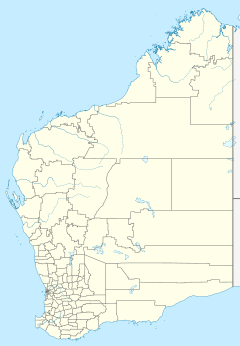
Onslow is a coastal town in the Pilbara region of Western Australia, 1,386 kilometres (861 mi) north of Perth. It has a population of 848 people and is located within the Shire of Ashburton local government area.

Tropical Cyclone Steve was a tropical cyclone that affected northern Australia from 27 February 2000 until 11 March 2000. Cyclone Steve was noted for its longevity and traversal of northern and western Australia. It impacted on regions of northern Queensland, the Northern Territory and Western Australia before clearing to the south of the continent. Steve is the first known Australian cyclone to make four distinct landfalls in the country.
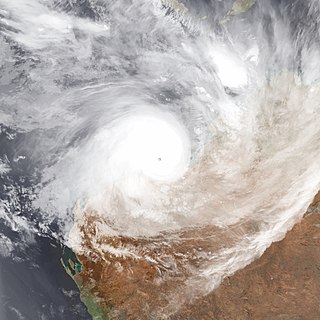
Severe Tropical Cyclone George was one of the most powerful Australian tropical cyclones on record, attaining a minimum barometric pressure of 902 mbar. It was also the strongest tropical cyclone worldwide in 2007 and the last Australian region tropical cyclone to achieve this record to date. The cyclone formed on 26 February 2007 in the Northern Territory's Top End, and intensified when it entered the Joseph Bonaparte Gulf, before crossing the northern coast of the Kimberley. It moved over the Indian Ocean, intensifying to a Category 4 cyclone, and eventually crossed the Pilbara coast just east of Port Hedland at peak intensity. After further analysis from the Bureau of Meteorology, George was reclassified to Category 5. The cyclone caused significant damage to the town of Port Hedland and numerous isolated mining camps around the town. Losses in Northern Territory amounted to at least A$12 million. Two people died and more than a dozen others were infected in a melioidosis outbreak following the Northern Territory floods. Insured damage in Western Australia amounted to $8 million, and there were three fatalities.

The 1995–96 Australian region cyclone season was an active Australian cyclone season, with Western Australia experiencing a record number of landfalling intense storms in the Pilbara region. The season produced a total of 19 tropical cyclones, of which 14 developed into named storms and 9 reached severe tropical cyclone status. The strongest of the season was Severe Tropical Cyclone Olivia, which also produced the highest recorded wind gust on record of 408 km/h (253 mph). Though several systems impacted land, the general sparsity of population centres in Australia limits the scale of damage. One person was confirmed to have been killed and cumulative losses were estimated at A$77 million (US$58.5 million).

The Fortescue River is an ephemeral river in the Pilbara region of Western Australia. It is the third longest river in the state.
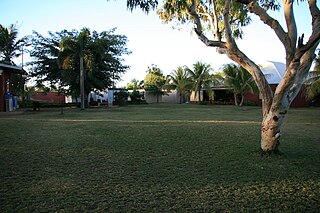
Pardoo Station is a pastoral lease, formerly a sheep station, and now a cattle station approximately 120 kilometres (75 mi) east of Port Hedland and 121 kilometres (75 mi) north of Marble Bar, in the Pilbara region of Western Australia.
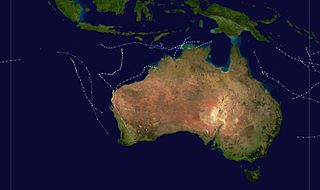
The 1974–75 Australian region cyclone season was an above average tropical cyclone season.

Tropical Cyclone Emma was a weak but unusually large tropical cyclone that affected a substantial portion of Western Australia during the 2005–06 Australian region cyclone season. Forming out of an area of low pressure on 25 February, the precursor to Emma slowly tracked southward. Although classified tropical, the structure of the system represented that of a monsoonal storm. However, low wind shear and well-developed outflow gradually allowed convection to develop near the centre of circulation. As the system approached the Pilbara coastline of Western Australia on 27 February, it intensified into a Category 1 cyclone and attained peak 10-minute sustained winds of 75 km/h (47 mph). After moving inland near Mardie, Emma weakened to a tropical low but became exceedingly large; its cloud cover obscured most of Western Australia. The remnants of the weak storm persisted until 1 March, at which time they dissipated over the Great Australian Bight.

Severe Tropical Cyclone Olivia was a powerful cyclone, the 13th named storm of the 1995–96 Australian region cyclone season, which formed on 3 April 1996 to the north of Australia's Northern Territory. The storm moved generally to the southwest, gradually intensifying off Western Australia. On 8 April, Olivia intensified into a severe tropical cyclone and subsequently turned more to the south, steered by a passing trough. On the morning of 10 April, passing over Barrow Island off the Western Australian northwest coast, Olivia produced the strongest non-tornadic winds ever recorded, with peak gusts of 408 kilometres per hour (254 mph). On the same day the cyclone made landfall on the Pilbara coast, about 75 kilometres (47 mi) north-northwest of Pannawonica. The storm quickly weakened over land, dissipating over the Great Australian Bight on 12 April.
Sherlock Station is a pastoral lease and sheep station located approximately 54 kilometres (34 mi) East of Roebourne in the Pilbara region of Western Australia. Covering an area of 216,700 acres (87,695 ha) pasture, the lease provides good grazing land. In 2015 it was purchased by Bettini Bros, now Bettini Beef, in a package with Mallina and Pyramid Stations. The Bettinis still owned the lease in 2018. Sherlock is operating under the Crown Lease number CL311-1966 and has the Land Act number LA3114/558.

Severe Tropical Cyclone Monty was a powerful category 4 tropical cyclone that formed during late February 2004. Monty was the 6th tropical cyclone and the 3rd Severe tropical cyclone of the 2003-04 Australian region cyclone season. Monty made landfall in a large, sparsely populated region of the Pilbara, Western Australia. Due to the low population, damages inland were not high, although there was major flooding and many roads were impassable because they were flooded or washed away by water. Monty set record high amounts of flooding in some parts of Western Australia.

Severe Tropical Cyclone Rusty was a strong, slow-moving tropical cyclone that produced record duration gale-force winds in Port Hedland, Western Australia in late February 2013. Originating as an area of low pressure on 22 February well to the northwest of the Kimberley region of Western Australia, the precursor to Rusty steadily developed within a favourable environment. Gradually decreasing surface pressures in the region signaled intensification and the low was classified as Tropical Cyclone Rusty on 23 February. Although a large, sprawling system, near-record high sea surface temperatures enabled Rusty to quickly deepen. Becoming essentially stationary on 25 February, the system acquired hurricane-force winds as its core improved in structure. The cyclone achieved its peak intensity two days later with maximum ten-minute sustained winds of 165 km/h (105 mph) and a barometric pressure of 944 hPa. Thereafter, interaction with land caused its core to collapse before the system made landfall near Pardoo Station. Rusty weakened below cyclone strength on 28 February. Its remnants persisted over Western Australia for several more days before being absorbed into an extratropical cyclone on 5 March.
Mount Welcome Station is a pastoral lease that once operated as a sheep station but is now operated as a cattle station in Western Australia.
Chirritta Station, most often referred to as Chirritta or Cherratta, is a pastoral lease operating as a sheep station in Western Australia.
Edjudina Station is a pastoral lease within the Edjudina Land District of Western Australia, that operates as a sheep station. The station is approximately 130 kilometres (80 mi) to the south of Laverton and 240 kilometres (150 mi) north east of Kalgoorlie in the Goldfields-Esperance region. The leasehold shares a boundary with Yundamindera Station.
Emu Creek or Emu Creek Station is a pastoral lease and cattle station located approximately 150 kilometres (93 mi) east of Coral Bay and 180 kilometres (112 mi) south east of Exmouth in the Ashburton-Gascoyne area of the Pilbara region of Western Australia. The property was established in 1891 as Wogoola Station, named for the permanent waterhole not far from the homestead site. In 1962 the station became Nyang under new management. In 2006 it was renamed Emu Creek.
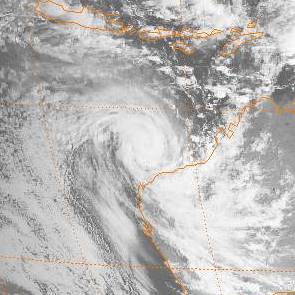
Severe Tropical Cyclone Ilona caused moderate damage across the Pilbara region of Western Australia in mid-December 1988. The system originated from a monsoon trough that coalesced into a tropical low over the Timor Sea on 12 December. The system initially moved southwest, before moving on a more westerly course. Steady intensification occurred and Ilona reached its peak strength on 17 December as a low-end severe tropical cyclone. A southward turn directed the cyclone toward Western Australia, and it made landfall near Mardie Station. The system subsequently degraded over land and dissipated on 19 December.
Mallina Station is a pastoral lease that was once a sheep station but now operates as a cattle station in Western Australia.
Mount Edgar Station, often referred to as Mount Edgar, is a pastoral lease that once operated as a sheep station but now operates as a cattle station.
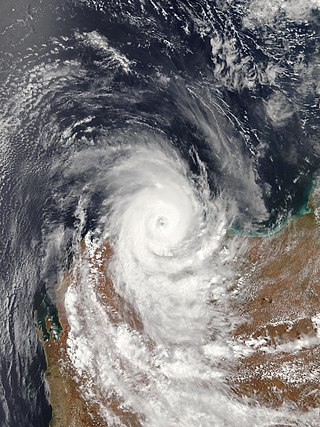
Severe Tropical Cyclone Damien was the strongest cyclone to make landfall on the Western Australian coast since Cyclone Christine in 2013 and the second-strongest cyclone in the 2019–20 Australian region cyclone season after Cyclone Ferdinand. The fifth tropical low, and the third named storm of the 2019–20 Australian region cyclone season, Damien originated from a monsoon trough over Kimberley.
